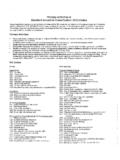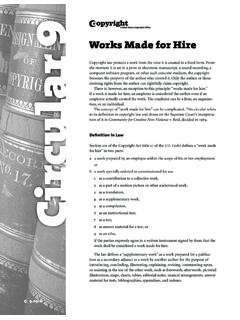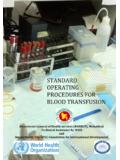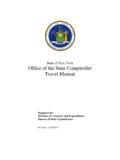Transcription of EMI Test Lab. com
1 emi test lab . com FCC - CE Mark Testing and Design Consulting Contact Dennis King at (303) 684-6650 How to Self-Certify For the CE Mark A Quick Start Guide by Dennis King - emi test lab For questions and details contact Dennis at Introduction The CE mark (an acronym for the French "Conformite Europeenne") certifies that a product meets EU health, safety, and environmental requirements, which ensure consumer safety and - for most products - also say that the product meets a minimum level of Quality with regards to EMI (Electro Magnetic Interference) and Product Safety. Manufacturers in the European Union (EU) and around the world must meet CE marking requirements in order to market their products in Europe. Here s a list of countries that require the CE mark; Austria Hungary Poland Belgium Iceland Portugal Bulgaria Ireland Romania Cyprus Italy Slovakia Czech Republic Latvia Slovenia Denmark Liechtenstein Spain Estonia Lithuania Sweden Finland Luxembourg Switzerland France Malta Turkey Germany Netherlands United Kingdom Greece Norway A manufacturer, who has gone through the conformity assessment process, may affix the CE mark to the product.
2 With CE marking, the product may be marketed throughout the EU. CE marking provides product access to 32 countries with a population of nearly 500 million. Here s a link to the Department of Commerce explaining how the Self-Certification process works US Dept of Commerce - Self-Certify for the CE Mark emi test lab . com FCC - CE Mark Testing and Design Consulting Contact Dennis King at (303) 684-6650 Overall Summary of the CE Mark Process A typical computing product 1. Determine if your product requires a Notified Body Lab or if you can Self-Certify . Most digital computing type products are eligible for Self-Certification . If a product can seriously hurt someone, is used in the operating room, or operates in a dangerous environment, the product probably requires a Notified Body to be involved.
3 See the details below for examples of products that can and cannot be Self-Certified . 2. Identify the appropriate standards for your product, usually EMC and Product Safety. 3. Conduct the EMC Testing (Emissions and Immunity) and have the Product evaluated for Product Safety and any other related standards. 4. When the EMC and Product Safety evaluations are finished, and you have passing test reports, create a one page Declaration of Conformity (DoC) document that will ship with the unit into the EU. See details of the DoC later in this guide. 5. Apply the CE Mark to the unit and Packaging. Most people also include the DoC as a page in the User Guide and include a copy with the shipping documents. 6. Create a Technical Construction File (TCF) that contains technical information to back up your claim that your product passes CE Mark requirements.
4 This file needs to be made available, upon request, to Government Authorities in the EU. 7. SHIP IT! into the EU. Although the EU has more tests for the CE Mark than the FCC requires in America, the EU has made the process simpler and quicker by allowing manufacturers to Self-Certify. Self-Certify means a manufacturer can create an in-house test lab that could do all the testing or use an outside resource that already has the test equipment and expertise such as emi test lab . emi test lab . com FCC - CE Mark Testing and Design Consulting Contact Dennis King at (303) 684-6650 The Details a typical computing product Does my Product Qualify for Self-Certification? 1. Some examples for which manufacturers can self-certify include: Safety of Machinery Directive Electromagnetic Compatibility (EMC) Directive this covers most computing devices Low Voltage Directive applies to most computing devices Class I products of the Medical Device Directive Most products covered by the Radio and Telecommunications Terminal Equipment (R&TTE) Directive 2.
5 Some examples of the directives that do not allow manufacturers to self-certify include: Simple Pressure Vessels Directive Appliances Burning Gaseous Fuels Directive Most products covered by the Pressure Equipment Directive Most products covered by the Equipment and Protective Systems in Potentially Explosive Atmospheres Directive What Standards Apply to my Product? There are many standards and this can become confusing. One way to get started is to look at the user guides of similar products, from major companies, and see which standards they quote. From there you can look at any of the companies that sell standards and they will let you see the first 10-20 pages or so, before you buy the standard, to determine if the standard applies to your product. Here are a few of the most common standards for EMC (Electro Magnetic Compatibility); EN 55022 - Information technology equipment.
6 Radio disturbance characteristics. Limits and methods of measurement EN 55024 - Information technology equipment. Immunity characteristics. Limits and methods of measurement EN 61326 1 - Electrical equipment for measurement, control and laboratory use. EMC requirements. General requirements EN 60601-1-2 - Medical electrical equipment. General requirements for basic safety and essential performance. Collateral standard. Electromagnetic compatibility. Requirements and tests emi test lab . com FCC - CE Mark Testing and Design Consulting Contact Dennis King at (303) 684-6650 Here are some of the Safety Standards; EN 60950-1 - Information technology equipment. Safety. General requirements EN 61010-1 - Safety requirements for electrical equipment for measurement, control, and laboratory use.
7 General requirements EN 60601-1-2 - Medical electrical equipment. General requirements for basic safety and essential performance. Collateral standard. Electromagnetic compatibility. Requirements and tests Testing for EMC and Product Safety Test Plan One of the requirements for EMC testing is a Test Plan. The information from the test plan can be used to issue a quote and also helps the test lab know how your product should be tested. Ideally, it s also an agreement between the manufacturer and the test lab that says we will test the product this way . Upon completion of this plan we agree that the product meets the applied standard. Emissions Test Plan Information For Emissions, some of the information required will describe the test modes, the I/O s and cables, the software, functionality of the unit and how worst case will be determined if the unit has several operating modes.
8 In general, all of the I/O s need to be exercised during the testing. There are many more details that are also included such as clock frequencies. A note about the dwell time of the Equipment Under Test (EUT) during emissions: Typical emissions tests , depending on the lab, can take from a half hour to 2 hours, in a chamber. Open Area test sites can take up to 6 hours to run a single scan. The EUT needs to run in the tested mode uninterrupted during the entire test. If the unit stops or has intermittent pauses, the test data may not be valid to show compliance. Immunity Test Plan Information For Immunity one of the most important pieces of information is how will the unit be monitored in order to know if the applied interference is affecting the equipment. Sometimes special software is written to put the unit in a loop mode that will make testing go faster.
9 A note about the dwell time of the Equipment Under Test (EUT) during immunity: Typical radiated immunity tests , depending on the sweep rate of the test equipment, can take 2-3 hours or more. This usually covers the 80 MHz to 1 GHz range of frequencies being radiated towards the EUT. The EUT needs to run continuously, uninterrupted during the entire test. If the unit stops or has intermittent pauses, the test may need to be stopped and re-started to make sure all frequency ranges are covered. The test lab will charge more since this extra time is outside the scope of a typical quote. emi test lab . com FCC - CE Mark Testing and Design Consulting Contact Dennis King at (303) 684-6650 Product Safety Testing User Manual, BOM, Schematics and electrical ratings are some of the first information a Product Safety Engineer looks for to determine compliance with Safety Standards.
10 Be prepared to answer many more questions as the evaluation continues. Why Test for EMC/EMI? (Electro Magnetic Compatibility Electro Magnetic Interference) Besides the 1993 EU Law that says your product must meet the requirements for the CE Mark, Radiated Emissions and Immunity issues are the reason why Hospitals don t want cell phone use and why you are not allowed to use electronic equipment when your flight is taking off. Very serious issues and loss of life has led to the legal requirements for manufacturers to test for these requirements. Since Emissions requirements reduce noise created by a product and Immunity requirements increase a Product s ability to reject noise the Product ends up becoming a higher Quality design. The worst case reason - if a product is found to be non-compliant, you can be fined and a recall of all equipment can be ordered.






